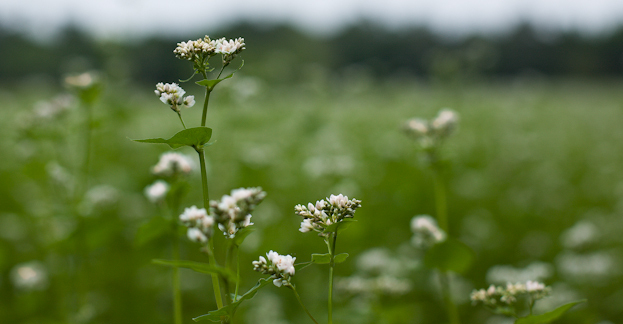What You Need to Know About Buckwheat

A number of curiosities surround the taxonomy, history, and cuisine of buckwheat. For starters, buckwheat shares no kinship whatever with wheat. It is not a grass, hence it is not a grain, and because it is not a grain, buckwheat begets no allergies in the gluten-averse. But precisely because buckwheat is gluten-free, and it is gluten that forms the structural buttress of baked goods and pasta, buckwheat finds itself fraternizing frequently with wheat flour in recipes, thus forfeiting its special cachet. The cachet buckwheat runs no danger of forfeiting is this: it possesses the highest average protein micronutrient profile of all grains—without being a grain at all.
Buckwheat seeds, wrested from a shrub related to rhubarb, consist of small, black outer hulls encapsulating pyramidal kernels cast in violet, faint green, purple, and white—kernels that are delicate, highly perishable, and difficult to mill. Milled correctly, buckwheat yields a silky flour that retains traces of pastel hues. Climate and topography figure prominently in its production: buckwheat prefers high altitudes and thrives on the drama between chilly autumn days and the first killing frost—when it is harvested—for optimal growth and flavor.
It is the pleasantly bitter, tannic component in its black hulls that accounts for buckwheat’s unique grip on the palate, one that is said to be something of an acquired taste. The inner kernels register as part wild greens, part green tea, and part dark earth, with a toasty nuttiness in the back palate. It is a thrilling, potent set of flavors.
Shelf-stable supermarket buckwheat flour and pancake mixes possess none of these appealing characteristics. Open the box, rip the bag, and discover how dead and one-dimensional buckwheat can be.
Buckwheat is one of the most ancient cultivated “grains” on earth, and it is fundamental to every Near and Far Eastern cuisine, from Romanian to Hunan. It shows up as toasted groats in the porridges and varnishkes that inform the stout soul of Jewish peasant cooking in provincial Russia and Poland, and in Brittany as galettes (which might be shredded and used in savory casseroles in place of noodles). A branch of rural Italian cooking fancies buckwheat’s rougher side, using quick, coarse milling practices that leave a preponderance of large, black bran flecks in the flour. In Japan, where the practice of milling whole-grain buckwheat to order goes back centuries to soba houses, buckwheat flour is finely milled and hand-wrought into thin noodles dipped cold or hot into broth.
Buckwheat is not native to the Americas and enjoys relatively little influence as a modern ingredient in the United States. Yet during our Colonial Era, buckwheat foodways reflected the odyssey of European culture to the American South, where it generally took the form of crêpes, ployes, and blini—delicate griddlecakes far more sophisticated than today’s buckwheat pancakes from a box.
Before 1900, crops were selected for drought tolerance, among other traits. Crops with deep roots remained viable during periods of drought and were able to take up diverse minerals and nutrients from the soil. A quickly maturing plant, buckwheat bushes out fast and produces a prodigious amount of biomass, creating a ground canopy that chokes out weeds which would otherwise rob crops of nutrition. But that’s not all. Buckwheat was also critical to farming in terms of crop rotation. (Crop rotation involves successive plantings of different crops interspersed with fallow periods to maintain soil health.) Buckwheat could be planted in the spring and turned back into the soil before it seeded to return potassium to the soil and render it accessible to later crops. (Corn, for instance, requires potassium to tassel and mature.) Two green-manure cycles—as they are known—of buckwheat could begin to restore marginally tillable or overfarmed land back to its original salubrity.
After 1900, buckwheat experienced the sting of neglect. Modern petroleum-based fertilizers provided readily available quantities of phosphorus, potassium, and nitrogen, thereby eliminating the need for buckwheat—or for any green-manure cycle at all. By the end of World War II, only small pockets of sustainable farms, such as those of the Amish and Shakers, grew buckwheat. Buckwheat became, in effect, a hobby crop—and essentially remains one today beyond the vast buckwheat commodity export industry. Its magical culinary applications once relished in this country have all but vanished in today.
Fortunately, renewed interest in sustainable farming has put buckwheat back into rotation. We have high hopes for its culinary second coming as well.
It is said that one must be an artisan to grow and mill quality buckwheat and a culinary artist to cook it: the aroma and flavor nuances of freshly milled buckwheat are fleeting. This is why the best soba houses in Japan still mill buckwheat to order. Soba houses are the oldest public eating establishments in the world, linking farmers, culinary arts and working chefs with buckwheat milling and tradition. The traditions and history of buckwheat run deep. This ought to tell us something.